NAKBA 2.0
Beatings, threats at gunpoint and fleeing in terror: Inside the most aggressive West Bank land grab in 50 yearsBel Trew
The Independent UK
Fri, November 10, 2023
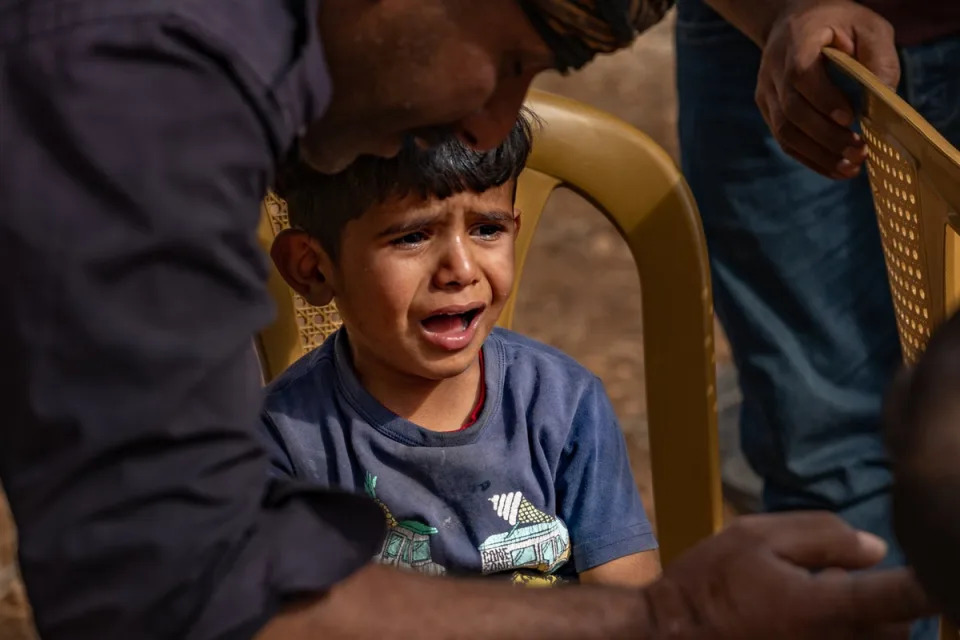
The six-year-old son of Ali Arrara, who has not stopped crying since the family were forced from their land at gunpoint (Bel Trew/The Independent)
The man in Israeli military uniform sliced off Mohamed’s clothes with a knife, urinated on him, and then, after relentlessly beating him, tried to rape him with a stick. He details the assault that took place in the village of Wadi al-Siq, about 20 miles northeast of Jerusalem in the occupied West Bank.
Mohamed Mattar, 46, a Palestinian activist and humanitarian, had come to this Bedouin community to assist 30 Palestinian families that lived there. They appealed for help as attacks by Israeli settlers across the occupied West Bank had surged and become dangerously violent in the aftermath of Hamas’s brutal attack in southern Israel on 7 October.
There were reports that armed settlers were planning a “cleansing day” in retaliation for the attack by Hamas that killed 1,400 people. And so on that day – 12 October – panicked families in Wadi al-Siq, who had already been subjected to multiple terrifying armed raids, decided to evacuate. With Mohamed’s help, they began loading the cars up, but before they could successfully leave, two pickup trucks arrived, packed with armed settlers and men in military uniforms.
Mohamed says the men – he identifies them as a mixed group of Israeli police, soldiers, and settlers in military uniforms – forced those gathered to empty their bags at gunpoint, and found kitchen knives among their belongings. Mohamed says they accused him of planning to stab one of them.
“They took me and two other men deep into the village so that no one could hear our voices. And then they took turns to hit us one by one for two hours,” Mohamed tells The Independent while showing photos of his injuries immediately after the attack, and of the scars that still crisscross his body. He was blindfolded, and his hands were bound by metal wire, which has left permanent gouge marks on his wrists.
He says one of his assailants – who he believes to have been an Israeli settler in military uniform – then cut off his clothes with a knife, sprayed him with water, urinated on him, and started beating him savagely with sticks and a rifle.
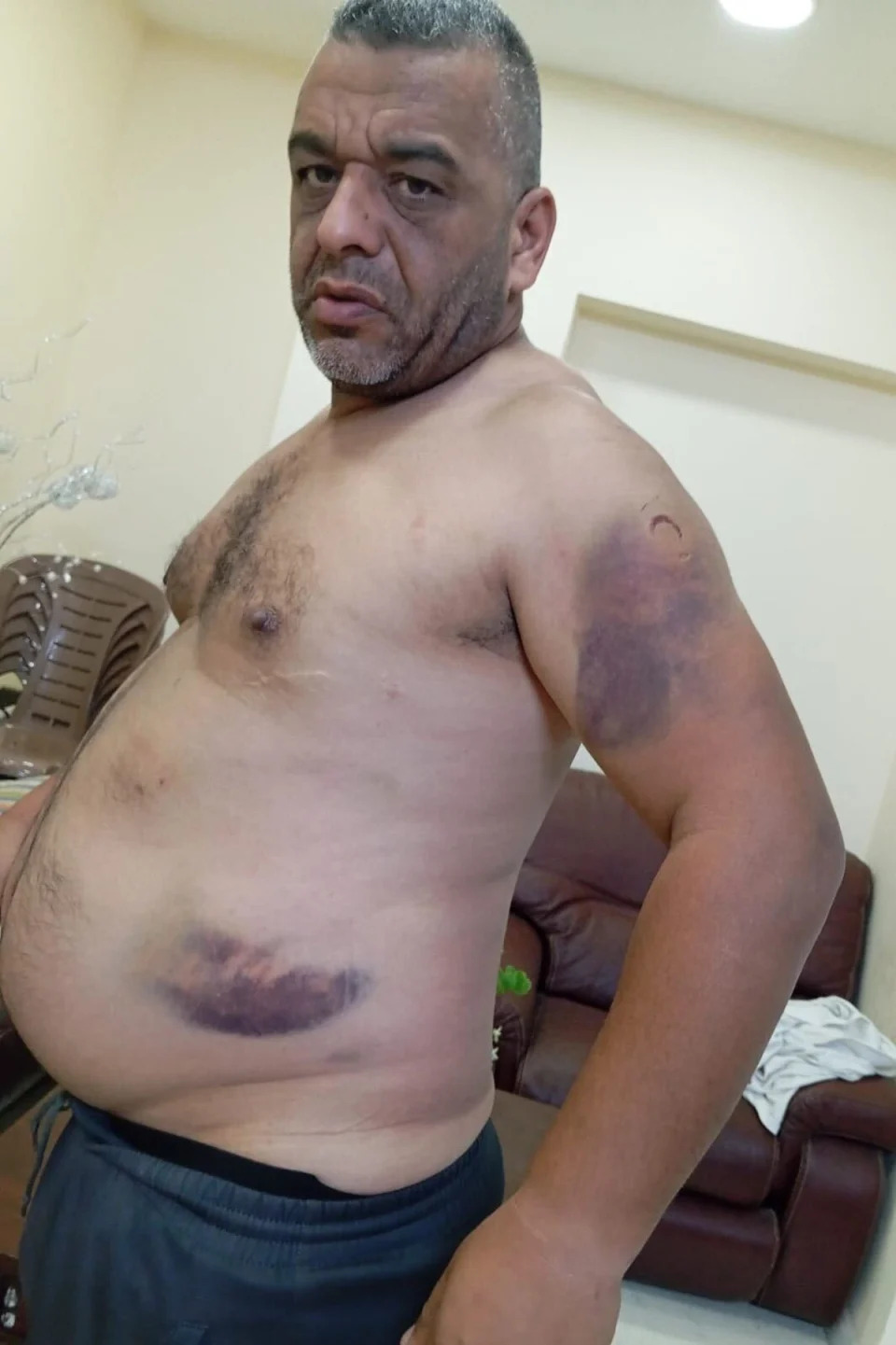
Mohamed Mattar, 46, shows the injuries he sustained in the assault (Mohamed Mattar)
“My attacker lost his mind – he started jumping on my back to break my spine, like he wanted to disable me. He kept shouting, “All Arabs should die. All who don’t die should go to Jordan,” Mohamed says.
Then the man tried to insert a stick into Mohamed’s anus, he says. “I fought him hard to get him off my back to stop him from assaulting me like this. He broke the stick into three pieces by beating me.”
In the end, after multiple calls were made to the Israeli military, a commander intervened. Mohamed was released and remains wounded weeks later.
But the 30 families, comprising 180 people including 25 children, were forced to flee their homes despite having lived in Wadi al-Siq for more than three decades.
“They told us at gunpoint we had to leave,” says Ali Arrara, 35, a father of five, speaking from a tent in an olive grove in a nearby town where he is now camping with the other displaced families.
“I wanted to take the medicine for my immunocompromised three-year-old daughter from the fridge, but they wouldn’t even allow me to do that.
“They destroyed the fridge and the medicines in front of me,” he adds.
The children now live in fear, and cannot stop crying. Behind Ali, one of his sons, a six-year-old boy, is in floods of tears.
“My older daughter, who is four years old, was so scared. Now, whenever she sees a car or pickup truck, she screams ‘They are coming,’” says Ali.
The story of Wadi al-Siq is not an isolated one. The occupied West Bank is fast “boiling over”, according to the UN, whose top officials have repeatedly raised the alarm. They fear a spillover risk from Gaza, which could open another front in this already devastating war.
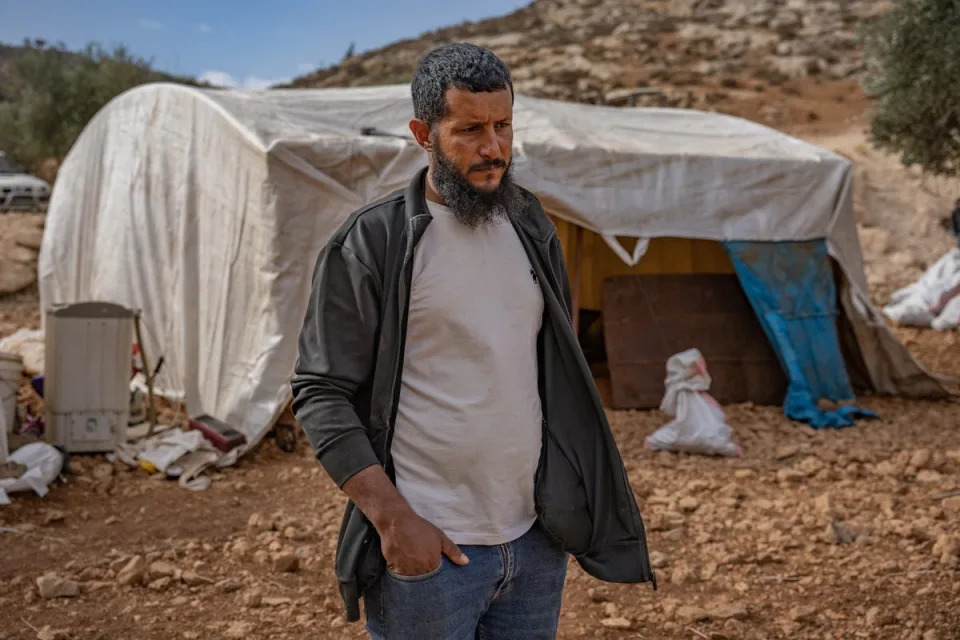
Ali Arrara, 35, by a tent in an olive grove where his family is now camping (Bel Trew/The Independent)
Around 450,000 Jewish settlers now live in the occupied West Bank, which is home to around 3 million Palestinians. The settlements – which range in size from hilltop caravans to sprawling commuter towns – are built on land captured by Israel in a 1967 war, and have been steadily expanding. They are illegal under international law, and are often cited as the main obstacle to peace, and to a two-state solution involving Palestine.
International and local rights groups say that “state-sponsored settler violence” has long been on the rise, and is used, alongside building restrictions and the strangling of access to amenities, to force Palestinians off their land. Most of this action is concentrated in Area C (where Wadi al-Siq is located), which makes up two-thirds of the West Bank. As laid out in the second Oslo Accord of 1995, it is under Israeli civilian control.
But these attacks, and land grabs, have accelerated in the month since Hamas’s brutal massacre, which Israel has responded to by ferociously bombing Gaza.
The United Nations says that since 7 October there has been a sevenfold increase in settler attacks on West Bank Palestinians in comparison to two years ago. “In nearly half of all incidents, Israeli forces were either accompanying or actively supporting the attacks,” says the UN’s humanitarian office, OCHA.
This year was already shaping up to be the deadliest for Palestinians in the West Bank in 20 years. That is now more true than ever. According to OCHA, in the last month, Israeli forces and settlers have killed 158 Palestinians, including 45 children. Three Israelis have been killed in attacks by Palestinians. Fifteen people have been killed by Israeli forces in the last 24 hours alone in Jenin city and the refugee camp located there.
Against the backdrop of violence, the UN says that almost 1,000 Palestinians – like the inhabitants of Wadi al-Siq – have been displaced from their lands in the last month alone. (An additional 162 people, half of them children, are displaced because Israel has demolished their homes.)
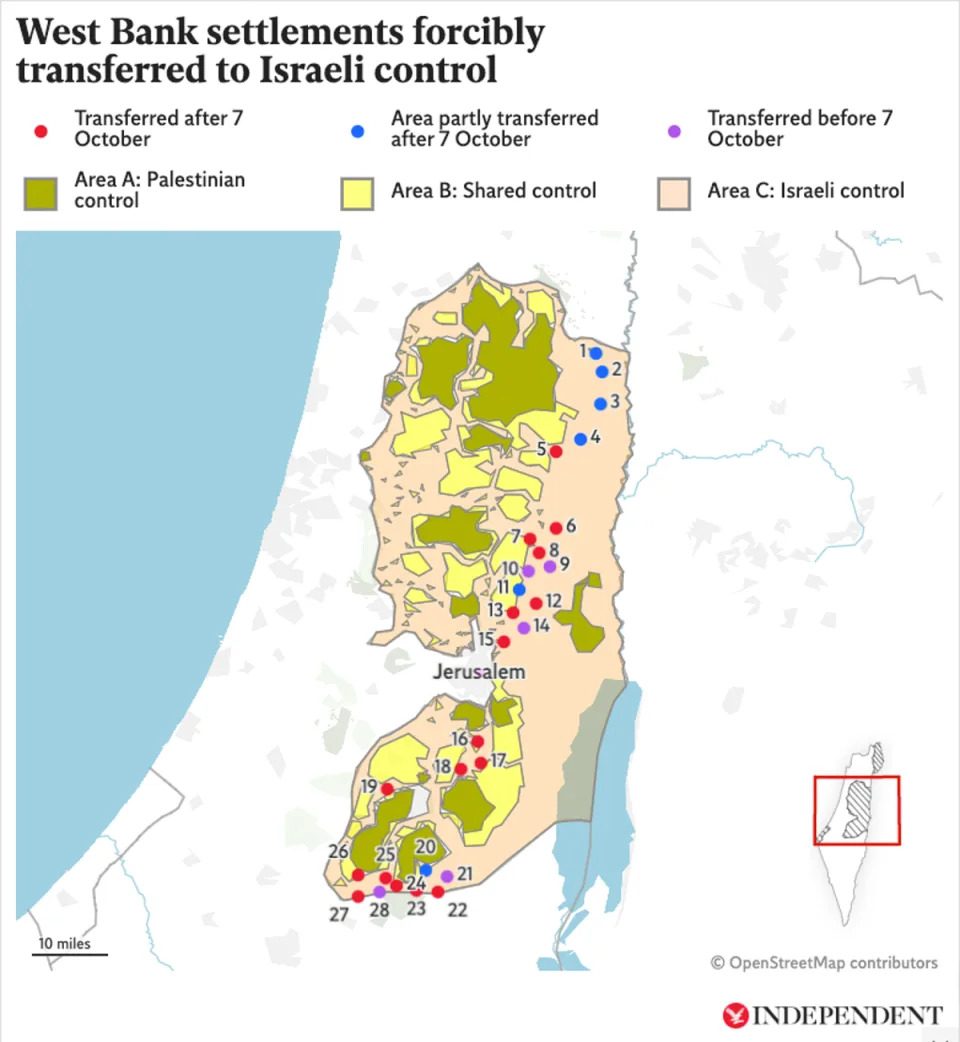
Israeli human rights groups say this is the single biggest land grab since Israel captured the West Bank in 1967, and likely amounts to the war crime of forcible transfer.
“This government is using the fact that all eyes are on Gaza right now to promote its agenda of taking over more Palestinian land,” says Roy Yellin of Btselem, an Israeli rights group that has documented the forced displacement of 15 Palestinian communities across the West Bank since 7 October.
“State-backed settler violence is one of the tools in this forced displacement. The threats are concrete: armed individuals threaten them with weapons and tell them they have 24 hours to leave. The inhabitants of Wadi al-Siq left without their belongings.”
The Independent has asked the military about these incidents, along with several others that have been caught on camera. The Independent spoke to one man who appeared in a video that showed eight Palestinian men blindfolded, bound on the ground, and partially stripped in Yatta, around 35 miles (55km) south of Wadi al-Siq. The man confirmed that the incident had taken place, but said he was too upset to talk about it.
Another disturbing video that surfaced online last week, also reported to have been filmed in Yatta, shows several men in Israeli uniform dragging a group of naked Palestinian workers on top of each other. One of the men in uniform kicks one of the Palestinian men in the face. The Independent has been unable to verify the video.
The Israeli military said: “The conduct of the force that emerges from the footage is deplorable and does not comply with the army’s orders. The circumstances of the incident are being examined.”
The military added that the conduct of the individuals who appeared in other videos “is not in line with the IDF’s orders”.
They did not comment on the actions of the individuals wearing military uniforms who attacked Wadi al-Siq on 12 October or the other communities whose members spoke to The Independent.
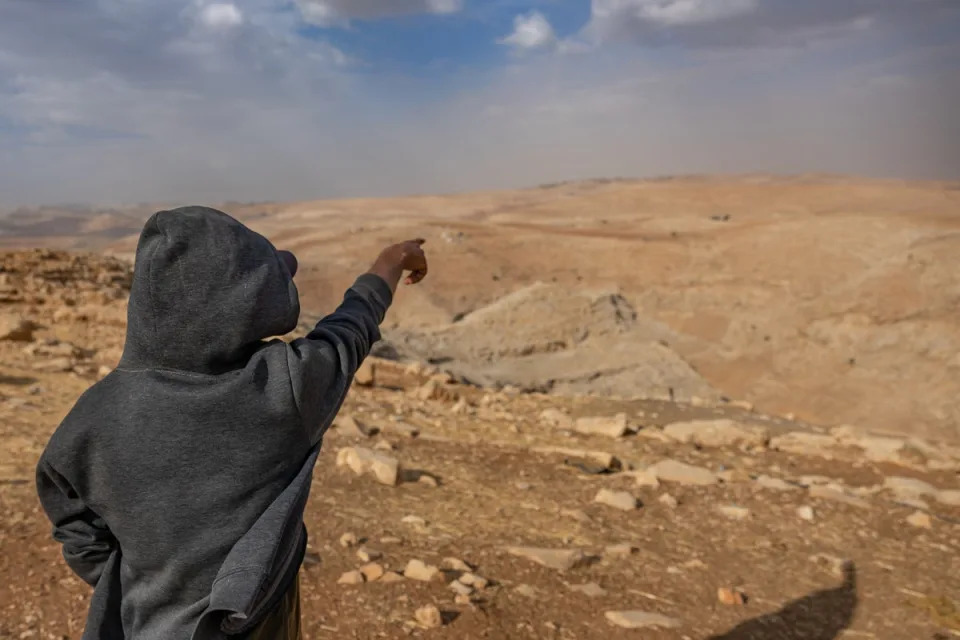
A man points towards Wadi al-Siq from the location where families have now been forced to stay (Bel Trew/The Independent)
The military said that the main body responsible for handling claims for law violations by Israelis is the Israel Police, and that the Palestinians should file a complaint with them.
“When IDF soldiers encounter incidents of violations of the law by Israelis, and especially violent incidents or incidents directed at Palestinians and their property, they are required to act to stop the violation and, if necessary, to delay or detain the suspects until the police arrive at the scene. IDF soldiers are instructed to act as follows,” the military added.
But the levels of violence have even worried Israel’s closest allies. US president Joe Biden has unsuccessfully lobbied Israeli prime minister Benjamin Netanyahu to rein in the violence from settlers. US secretary of state Antony Blinken said this week that Washington had repeatedly “made very clear our concerns about extremist violence in the West Bank”.
“We’ve heard the Israeli government make commitments on dealing more effectively with that, and we’re watching very closely to make sure that that happens,” he said recently.
In a letter to Britain’s foreign secretary, James Cleverly, Labour’s shadow foreign secretary, David Lammy, has also raised his concerns about the “sharp increase in violence and displacement of Palestinians in the West Bank”.
Since the Hamas attack in October, he said, “there has been an increase in recordings of instances of settler violence, threats, and intimidation against Palestinian communities – with homes vandalised, water supplies cut, livestock stolen and civilians threatened at gunpoint”. He added: “As the occupying power, Israel has obligations under international law that it must uphold.”
Rights groups say the biggest concern right now is the fact that settlers feel emboldened, with hate against Palestinians having surged since 7 October. It comes as the Israeli government is trying to sign settlers up to the military, and to new civilian rapid-response teams in the occupied West Bank, in the wake of the Hamas attack.
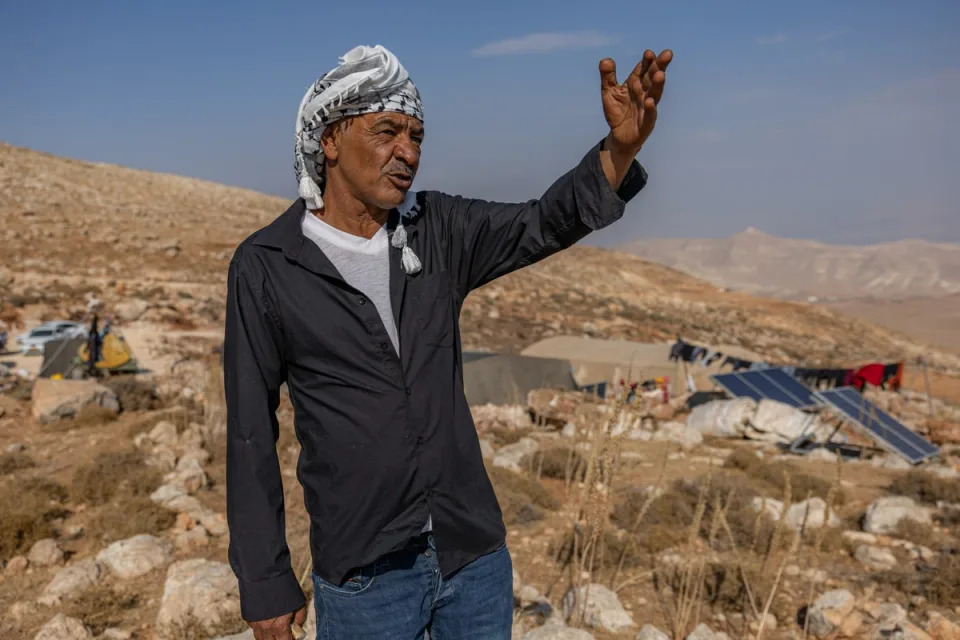
Abu Mohamed Suleiman, 52, who was forcibly displaced from Ein Rashash (Bel Trew/The Independent)
The national security minister, Itamar Ben Gvir – a far-right pro-settler politician – has gone as far as to announce that his ministry is purchasing thousands of rifles to arm these new militias.
Haaretz, a left-leaning Israeli daily newspaper, has reported that the military intends to recruit settlers aged between 27 and 50 who have not undergone military service.
“The recruits are expected to undergo accelerated basic training for three weeks, after which they will be armed and stationed in the settlements,” the paper wrote, adding that since the outbreak of the war in Gaza, the IDF has handed out some 8,000 weapons to regional defence battalions in the West Bank.
Concerns over the mass arming of settlers have prompted the US into action. On Tuesday, state department spokesperson Vedant Patel said that Washington had sought assurances from Israel that a new shipment of US rifles, including M-16s, would only go to government agencies and not to civilian rapid-response teams.
“We have heard from the Israeli government that they are going to make a commitment on dealing with extremist violence more effectively,” Patel said.
For the Palestinians, it is extremely frightening. Rania Zuwahara, 43, who has 10 children, is among 85 villagers who were recently forced out of their home village of Ein Rashash, close to Wadi al-Siq. She says that residents have long dealt with attacks from settlers, but their “fear is 10 times worse after the war”.
She says her community was threatened with armoured bulldozers and men with rifles multiple times before the final attack took place a few weeks ago. The villagers are now scattered across a number of locations, and they have no idea where they will live in the long term.
“This was our land for 33 years and we were evicted from it at gunpoint. It is a hellish feeling you can’t explain. We lived in fear every day,” says Rania. “It is so obvious what they [settlers] are doing – they have been trying to do this long before the war, but they are pushing forward 10 times as hard.”

The six-year-old son of Ali Arrara, who has not stopped crying since the family were forced from their land at gunpoint (Bel Trew/The Independent)
The man in Israeli military uniform sliced off Mohamed’s clothes with a knife, urinated on him, and then, after relentlessly beating him, tried to rape him with a stick. He details the assault that took place in the village of Wadi al-Siq, about 20 miles northeast of Jerusalem in the occupied West Bank.
Mohamed Mattar, 46, a Palestinian activist and humanitarian, had come to this Bedouin community to assist 30 Palestinian families that lived there. They appealed for help as attacks by Israeli settlers across the occupied West Bank had surged and become dangerously violent in the aftermath of Hamas’s brutal attack in southern Israel on 7 October.
There were reports that armed settlers were planning a “cleansing day” in retaliation for the attack by Hamas that killed 1,400 people. And so on that day – 12 October – panicked families in Wadi al-Siq, who had already been subjected to multiple terrifying armed raids, decided to evacuate. With Mohamed’s help, they began loading the cars up, but before they could successfully leave, two pickup trucks arrived, packed with armed settlers and men in military uniforms.
Mohamed says the men – he identifies them as a mixed group of Israeli police, soldiers, and settlers in military uniforms – forced those gathered to empty their bags at gunpoint, and found kitchen knives among their belongings. Mohamed says they accused him of planning to stab one of them.
“They took me and two other men deep into the village so that no one could hear our voices. And then they took turns to hit us one by one for two hours,” Mohamed tells The Independent while showing photos of his injuries immediately after the attack, and of the scars that still crisscross his body. He was blindfolded, and his hands were bound by metal wire, which has left permanent gouge marks on his wrists.
He says one of his assailants – who he believes to have been an Israeli settler in military uniform – then cut off his clothes with a knife, sprayed him with water, urinated on him, and started beating him savagely with sticks and a rifle.

Mohamed Mattar, 46, shows the injuries he sustained in the assault (Mohamed Mattar)
“My attacker lost his mind – he started jumping on my back to break my spine, like he wanted to disable me. He kept shouting, “All Arabs should die. All who don’t die should go to Jordan,” Mohamed says.
Then the man tried to insert a stick into Mohamed’s anus, he says. “I fought him hard to get him off my back to stop him from assaulting me like this. He broke the stick into three pieces by beating me.”
In the end, after multiple calls were made to the Israeli military, a commander intervened. Mohamed was released and remains wounded weeks later.
But the 30 families, comprising 180 people including 25 children, were forced to flee their homes despite having lived in Wadi al-Siq for more than three decades.
“They told us at gunpoint we had to leave,” says Ali Arrara, 35, a father of five, speaking from a tent in an olive grove in a nearby town where he is now camping with the other displaced families.
“I wanted to take the medicine for my immunocompromised three-year-old daughter from the fridge, but they wouldn’t even allow me to do that.
“They destroyed the fridge and the medicines in front of me,” he adds.
The children now live in fear, and cannot stop crying. Behind Ali, one of his sons, a six-year-old boy, is in floods of tears.
“My older daughter, who is four years old, was so scared. Now, whenever she sees a car or pickup truck, she screams ‘They are coming,’” says Ali.
The story of Wadi al-Siq is not an isolated one. The occupied West Bank is fast “boiling over”, according to the UN, whose top officials have repeatedly raised the alarm. They fear a spillover risk from Gaza, which could open another front in this already devastating war.

Ali Arrara, 35, by a tent in an olive grove where his family is now camping (Bel Trew/The Independent)
Around 450,000 Jewish settlers now live in the occupied West Bank, which is home to around 3 million Palestinians. The settlements – which range in size from hilltop caravans to sprawling commuter towns – are built on land captured by Israel in a 1967 war, and have been steadily expanding. They are illegal under international law, and are often cited as the main obstacle to peace, and to a two-state solution involving Palestine.
International and local rights groups say that “state-sponsored settler violence” has long been on the rise, and is used, alongside building restrictions and the strangling of access to amenities, to force Palestinians off their land. Most of this action is concentrated in Area C (where Wadi al-Siq is located), which makes up two-thirds of the West Bank. As laid out in the second Oslo Accord of 1995, it is under Israeli civilian control.
But these attacks, and land grabs, have accelerated in the month since Hamas’s brutal massacre, which Israel has responded to by ferociously bombing Gaza.
The United Nations says that since 7 October there has been a sevenfold increase in settler attacks on West Bank Palestinians in comparison to two years ago. “In nearly half of all incidents, Israeli forces were either accompanying or actively supporting the attacks,” says the UN’s humanitarian office, OCHA.
This year was already shaping up to be the deadliest for Palestinians in the West Bank in 20 years. That is now more true than ever. According to OCHA, in the last month, Israeli forces and settlers have killed 158 Palestinians, including 45 children. Three Israelis have been killed in attacks by Palestinians. Fifteen people have been killed by Israeli forces in the last 24 hours alone in Jenin city and the refugee camp located there.
Against the backdrop of violence, the UN says that almost 1,000 Palestinians – like the inhabitants of Wadi al-Siq – have been displaced from their lands in the last month alone. (An additional 162 people, half of them children, are displaced because Israel has demolished their homes.)

Israeli human rights groups say this is the single biggest land grab since Israel captured the West Bank in 1967, and likely amounts to the war crime of forcible transfer.
“This government is using the fact that all eyes are on Gaza right now to promote its agenda of taking over more Palestinian land,” says Roy Yellin of Btselem, an Israeli rights group that has documented the forced displacement of 15 Palestinian communities across the West Bank since 7 October.
“State-backed settler violence is one of the tools in this forced displacement. The threats are concrete: armed individuals threaten them with weapons and tell them they have 24 hours to leave. The inhabitants of Wadi al-Siq left without their belongings.”
The Independent has asked the military about these incidents, along with several others that have been caught on camera. The Independent spoke to one man who appeared in a video that showed eight Palestinian men blindfolded, bound on the ground, and partially stripped in Yatta, around 35 miles (55km) south of Wadi al-Siq. The man confirmed that the incident had taken place, but said he was too upset to talk about it.
Another disturbing video that surfaced online last week, also reported to have been filmed in Yatta, shows several men in Israeli uniform dragging a group of naked Palestinian workers on top of each other. One of the men in uniform kicks one of the Palestinian men in the face. The Independent has been unable to verify the video.
The Israeli military said: “The conduct of the force that emerges from the footage is deplorable and does not comply with the army’s orders. The circumstances of the incident are being examined.”
The military added that the conduct of the individuals who appeared in other videos “is not in line with the IDF’s orders”.
They did not comment on the actions of the individuals wearing military uniforms who attacked Wadi al-Siq on 12 October or the other communities whose members spoke to The Independent.

A man points towards Wadi al-Siq from the location where families have now been forced to stay (Bel Trew/The Independent)
The military said that the main body responsible for handling claims for law violations by Israelis is the Israel Police, and that the Palestinians should file a complaint with them.
“When IDF soldiers encounter incidents of violations of the law by Israelis, and especially violent incidents or incidents directed at Palestinians and their property, they are required to act to stop the violation and, if necessary, to delay or detain the suspects until the police arrive at the scene. IDF soldiers are instructed to act as follows,” the military added.
But the levels of violence have even worried Israel’s closest allies. US president Joe Biden has unsuccessfully lobbied Israeli prime minister Benjamin Netanyahu to rein in the violence from settlers. US secretary of state Antony Blinken said this week that Washington had repeatedly “made very clear our concerns about extremist violence in the West Bank”.
“We’ve heard the Israeli government make commitments on dealing more effectively with that, and we’re watching very closely to make sure that that happens,” he said recently.
In a letter to Britain’s foreign secretary, James Cleverly, Labour’s shadow foreign secretary, David Lammy, has also raised his concerns about the “sharp increase in violence and displacement of Palestinians in the West Bank”.
Since the Hamas attack in October, he said, “there has been an increase in recordings of instances of settler violence, threats, and intimidation against Palestinian communities – with homes vandalised, water supplies cut, livestock stolen and civilians threatened at gunpoint”. He added: “As the occupying power, Israel has obligations under international law that it must uphold.”
Rights groups say the biggest concern right now is the fact that settlers feel emboldened, with hate against Palestinians having surged since 7 October. It comes as the Israeli government is trying to sign settlers up to the military, and to new civilian rapid-response teams in the occupied West Bank, in the wake of the Hamas attack.

Abu Mohamed Suleiman, 52, who was forcibly displaced from Ein Rashash (Bel Trew/The Independent)
The national security minister, Itamar Ben Gvir – a far-right pro-settler politician – has gone as far as to announce that his ministry is purchasing thousands of rifles to arm these new militias.
Haaretz, a left-leaning Israeli daily newspaper, has reported that the military intends to recruit settlers aged between 27 and 50 who have not undergone military service.
“The recruits are expected to undergo accelerated basic training for three weeks, after which they will be armed and stationed in the settlements,” the paper wrote, adding that since the outbreak of the war in Gaza, the IDF has handed out some 8,000 weapons to regional defence battalions in the West Bank.
Concerns over the mass arming of settlers have prompted the US into action. On Tuesday, state department spokesperson Vedant Patel said that Washington had sought assurances from Israel that a new shipment of US rifles, including M-16s, would only go to government agencies and not to civilian rapid-response teams.
“We have heard from the Israeli government that they are going to make a commitment on dealing with extremist violence more effectively,” Patel said.
For the Palestinians, it is extremely frightening. Rania Zuwahara, 43, who has 10 children, is among 85 villagers who were recently forced out of their home village of Ein Rashash, close to Wadi al-Siq. She says that residents have long dealt with attacks from settlers, but their “fear is 10 times worse after the war”.
She says her community was threatened with armoured bulldozers and men with rifles multiple times before the final attack took place a few weeks ago. The villagers are now scattered across a number of locations, and they have no idea where they will live in the long term.
“This was our land for 33 years and we were evicted from it at gunpoint. It is a hellish feeling you can’t explain. We lived in fear every day,” says Rania. “It is so obvious what they [settlers] are doing – they have been trying to do this long before the war, but they are pushing forward 10 times as hard.”
Displaced Gazans live in dust, fear and hunger
Khan Yunis (Palestinian Territories) (AFP) – At first Youssef Mehna thought the war would quickly be over. Then he was wounded, his house was destroyed, and he was forced to survive "25 days without anything".
Issued on: 12/11/2023

Khan Yunis (Palestinian Territories) (AFP) – At first Youssef Mehna thought the war would quickly be over. Then he was wounded, his house was destroyed, and he was forced to survive "25 days without anything".
Issued on: 12/11/2023

Displaced Palestinian children wait for food in Khan Yunis © MAHMUD HAMS / AFP
So like thousands of others, Mehna finally fled north Gaza for the south.
Perched on trucks, crammed into cars, pulled by donkeys on carts, and on foot, tens of thousands of Palestinians are fleeing Israeli army strikes on the territory squeezed between Israel, Egypt and the Mediterranean.
At the Bani Suheila crossroads in Khan Yunis, on the immense Salah Al-Din road that threads Gaza top to bottom, the processions are growing still.
People fleeing Gaza City are joined by those leaving Khan Yunis heading further south, towards Rafah, the last city before Egypt.
Mehna left the Jabalia refugee camp at seven in the morning, in the north of Gaza City, also hoping to reach Rafah.
But his journey finished in Khan Yunis, after eight hours of travel covering only 25 kilometres (15 miles).
"I already paid 500 shekels ($130) to come from Jabalia and so I have nothing more to carry on to Rafah," he said with a drawn face, surrounded by his six children.
'Not even a morsel of bread'
Because his sick wife is in a wheelchair, he had to rent "carts pulled by donkeys, trucks, cars" to transport her.
Each trip was short, as fuel shortages prevent drivers from accepting long-distance fares.
 A displaced Palestinian family from northern Gaza now shelters in the grounds of a Khan Yunis school © MAHMUD HAMS / AFP
A displaced Palestinian family from northern Gaza now shelters in the grounds of a Khan Yunis school © MAHMUD HAMS / AFP
Sometimes, between car rides, they were forced to go on foot. "So it was me who pushed my wife's chair," he told AFP.
Around him, hundreds of families were waiting.
Children sleep on the floor beside parents wondering how they will live in a territory where more than 1.5 million people are displaced and nearly one house in two has been destroyed, according to the United Nations.
In southern Gaza, overflowing with displaced from the north, rents of $150 a month are now up to $500 to $1000.
"I don't even have a morsel of bread to feed my kids," said Umm Yaaqub. "Since six in the morning I have been looking everywhere."
"I can't give them anything to eat," added the 42-year-old, who arrived in Khan Yunis three days ago with her husband and seven children from Gaza City.
The UN has said access to bread in the south is "challenging" because "the only operative mill in Gaza remains unable to grind wheat due to a lack of electricity and fuel".
On October 7 Hamas, in power in Gaza, launched an attack on southern Israel, killing some 1,200 people, mostly civilians and taking 239 hostages, according to Israel.
Since then Israel has been bombing the Gaza Strip and has killed more than 11,000 people, also mostly civilians, according to the Hamas health ministry.
 A displaced woman sits outside a makeshift tent in the grounds of a school in Khan Yunis © MAHMUD HAMS / AFP
A displaced woman sits outside a makeshift tent in the grounds of a school in Khan Yunis © MAHMUD HAMS / AFP
Before the war, a little over 80 per cent of Gazans lived in poverty and almost two-thirds were dependent on international aid, especially for food, according to the UN.
Now, 50-kilo sacks of flour have increased in price from 40 shekels to 150 shekels, so it's worse still.
'Not a single shekel'
But hunger is not the only worry for Umm Yaaqub. "My husband has heart problems," she says.
And her 20-year-old daughter Rim "is normally in a medical bed". "But we all sleep on the ground, in the dust, and we don't have a single blanket even though the nights are very cold."
Her husband Atef Abu Jarad, 47, remains in a classroom on the first floor of a school where the family camps now, next to dozens of other displaced.
"I'm the head of the family, but I don't have a single shekel to buy something for my kids to eat," he laments.
 Still time for play: displaced Palestinian children who now live in a Khan Yunis school © Mahmud HAMS / AFP
Still time for play: displaced Palestinian children who now live in a Khan Yunis school © Mahmud HAMS / AFP
Shops across southern Gaza are running out of everything. Bottled water, milk for children, nappies, pasta and juices are now nearly impossible to find.
A little food aid is trickling through to the displaced according to Abu Jarad: "a portion of rice to share between seven" members of his family.
"So I take a small spoon of rice and I tell them I'm full so they can eat," he says.
Water flows from a tap where long crowds of displaced people queue. "People push and I don't have the strength to resist," he says.
His daughter Rim had to give up the painkillers she has taken since birth, because she suffers spinal and shoulder malformations.
She too forgoes meals because her brothers and sisters "have more need to eat".
© 2023 AFP
‘Please stop this.’ Gaza’s hospitals are failing under the weight of war. US medical groups are scrambling to help
Alaa Elassar, CNN
Sat, November 11, 2023
Dr. Mohammed Ghneim has not left his hospital in Gaza City in four weeks. He can’t remember the last time he slept or ate, and his blue scrubs are stained in the blood of patients who’ve died in his arms.
His voice cracks under the weight of the horrors he’s seen: fetuses pulled from the wombs of dying mothers, children with crushed lungs struggling to breathe, and his own colleagues – doctors, nurses and EMTs – transported to the hospital morgue in body bags.
“We are doing our best – this is why we haven’t left here for days – but the situation is very horrible. There’s no way to describe it in any language or with any words,” Ghneim told CNN in a voice message on November 7, as sounds of chaos and panic unfolded around him. “Many times I want to go to the side and cry, but unfortunately there is no time.”
Ghneim is an emergency room doctor at Dar Al-Shifa, also known as Al-Shifa Hospital or Shifa, and is Arabic for “house of healing.” But at this hospital – the largest medical complex in Gaza – there’s far too much death.
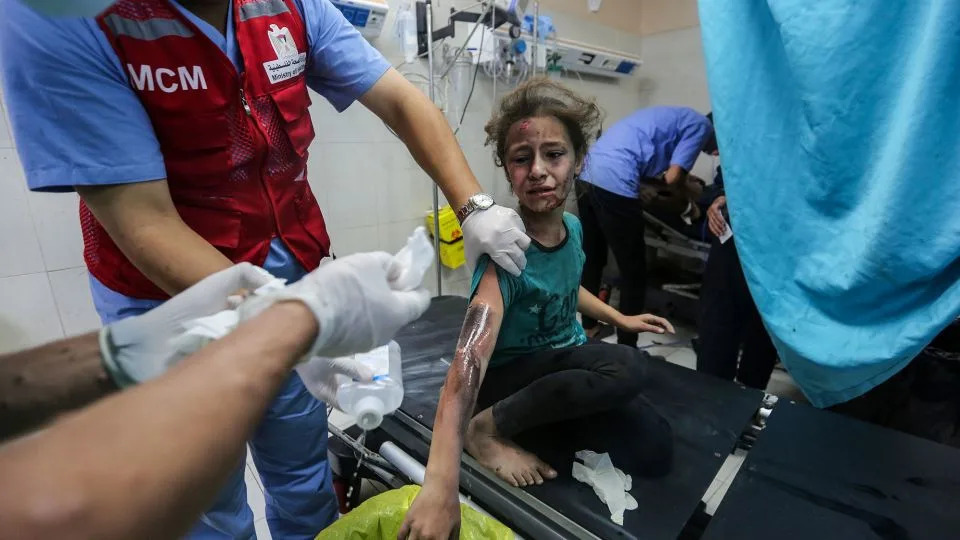
A Palestinian child receives treatment at Nasser Medical Center after a strike in Khan Younis, Gaza, on November 7. - Ahmad Hasaballah/Getty Images
Shifa is running dangerously low on clean water, medicine, supplies and fuel. Meanwhile, thousands of Palestinians, injured or displaced by Israel’s war against Hamas, continue to pack its wards, seeking shelter from the seemingly endless barrage of airstrikes.
Israeli forces on Saturday surrounded Shifa in all directions, threatening the health and safety of those inside, according to Dr. Munir Al-Bursh, director-general of the Hamas-controlled health ministry in Gaza.
An Israeli airstrike destroyed the hospital’s generator, Al-Bursh said, cutting electricity to the building, including life-saving equipment used by 39 infants in neonatal care. Three infants have already died, he added.
The Israeli military denied that the hospital is under siege, telling CNN it was engaged in “ongoing intense fighting” against Hamas in the vicinity of Shifa, but declined to comment further on its forces’ proximity to the complex because military activity was still underway. Israel has accused Hamas of using hospitals as cover — a charge doctors at Shifa and the militant group deny.
“We are trained to deal with mass casualties, but not like this,” Ghneim, 28, said. “We have no anesthesia to treat patients with severe pain, patients with shrapnel in their head or abdomen, people whose arms or legs have been amputated.”
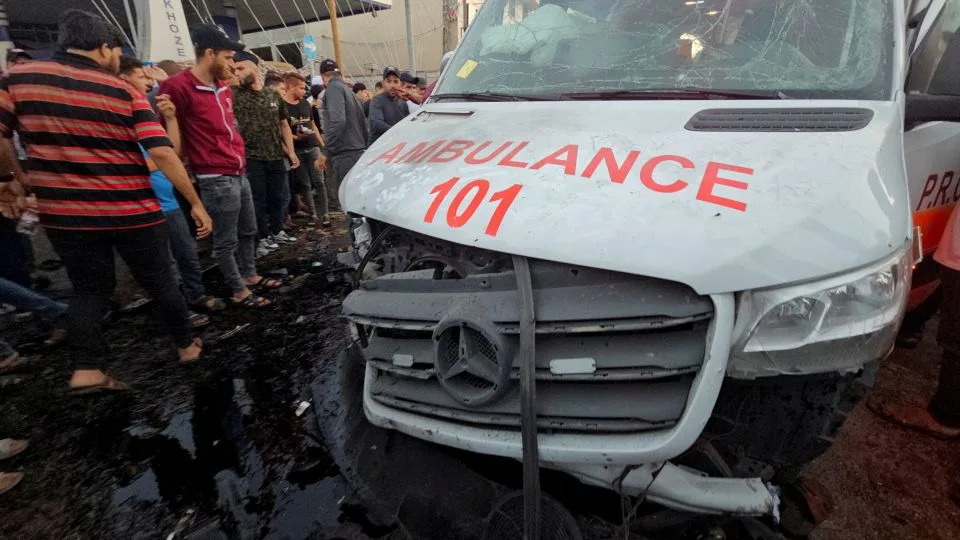
Palestinians inspect the damage to an ambulance struck by the Israeli military at the entrance of Al-Shifa Hospital in Gaza City. - Anas al-Shareef/Reuters
Alarming scenes from inside Shifa, and other hospitals across Gaza, have sparked international calls for a ceasefire and more aid to be allowed to enter the territory, home to some 2 million Palestinians, currently closed off to the world by Israel and Egypt.
Nonprofit medical groups across the United States are mobilizing to raise funds and ship medicine and supplies to failing hospitals before it’s too late. But with the situation in Gaza spiraling and few diplomatic or humanitarian solutions in sight, many worry the delay will result in more deaths.
“I want to say to the world, this is a humanitarian crisis, this is a genocide,” Ghneim pleaded from his crowded emergency room. “Please stop this.”
‘Desperate to send help’
More than 7,000 miles away, in Houston, Mosab Nasser is making travel plans to visit communities where he can spread awareness about the situation in Gaza and raise funds for struggling hospitals.
The proud Texan, born and raised in Gaza, says it’s all he’s been doing since October 7, when Israel declared war following a brazen attack by Hamas that killed around 1,200 people and took more than 230 others hostage, according to Israeli authorities.
Israel responded by imposing a siege and launching devastating airstrikes across Gaza, which Hamas governs. Israel says its goal is to destroy the militant group and return the hostages, but it is the Palestinian people living there who are bearing the brunt of the attacks.
The airstrikes have killed at least 11,025 Palestinians, including 4,506 children, and wounded more than 27,000 others so far, according to the Palestinian Ministry of Health in Ramallah, which draws its figures from sources in Hamas-run Gaza.
Nasser says three of his relatives – all young children, including one who was only 8 months old – were killed when Israeli airstrikes caused their home to collapse, but he has no time to grieve.
As CEO of the nonprofit medical group FAJR Scientific, he is obligated to find a way to deliver aid and other resources to hospitals in need.
FAJR Scientific’s goal is to raise enough money to fill five 40-foot containers with medical supplies, surgical tools and sterile instruments, and ship them to Gaza, Nasser says.
“Doctors in Gaza don’t get to go home. It’s traumatic for them,” Nasser said. “They are exhausted. Their bodies are physically at the hospital, but their minds are with their families trying to check on them.”
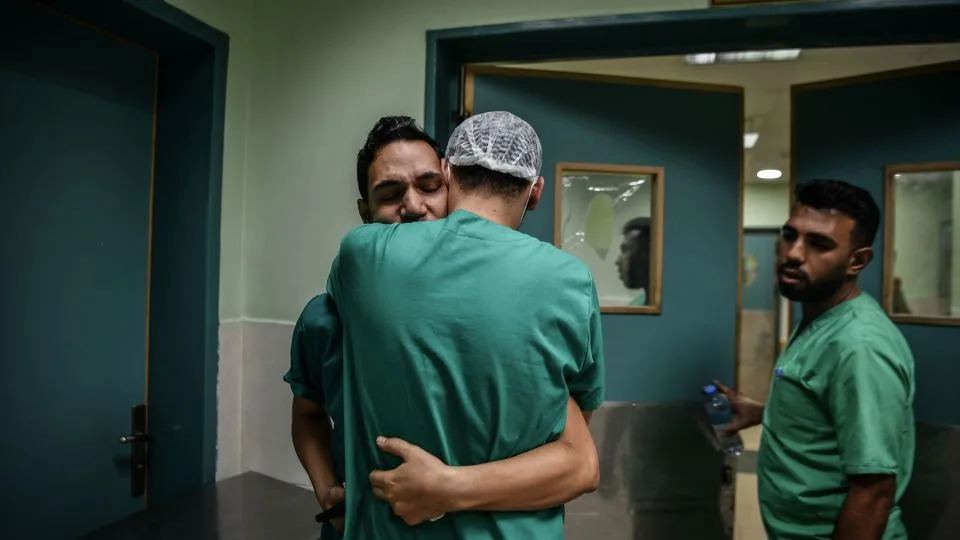
A Palestinian nurse at Nasser Hospital in Khan Younis, Gaza, mourns after receiving news that his brother was killed on November 9. - Abed Zagout/Anadolu/Getty Images
In some cases, Nasser says, medical workers have discovered their own loved ones among the injured or dead, compounding the fears and anxieties they already experience.
It’s not the first time FAJR Scientific has supported Gaza’s medical community. The group has led several surgical missions to Gaza and trained nearly 100 Palestinian medical workers on the ground, Nasser says. In August, they provided more than $4 million in medical supplies to hospitals across the territory.
The Palestinian American Medical Association (PAMA), another US-based nonprofit, is also leading efforts to assist health care workers in Gaza.
The group, which has more than 6,000 members and supporters and leads medical missions to the region, has raised over $2 million so far, PAMA president Dr. Mustafa Musleh told CNN.
They will use the money to purchase critical medicine and supplies, including anesthetics, antibiotics and other medications to fill containers that will be sent to Gaza. The group also has more than 1,000 health-care professionals on standby to enter the enclave as soon as Israel and Egypt allow entry to humanitarian workers, Musleh says.
“We’re desperate to send help,” the Palestinian American doctor from Dayton, Ohio, said. “It’s a catastrophic situation. … There’s 10 times more patients than what the hospitals can take care of and they’re all coming with serious life-threatening injuries that need immediate attention, and a lot of people die because of that.”
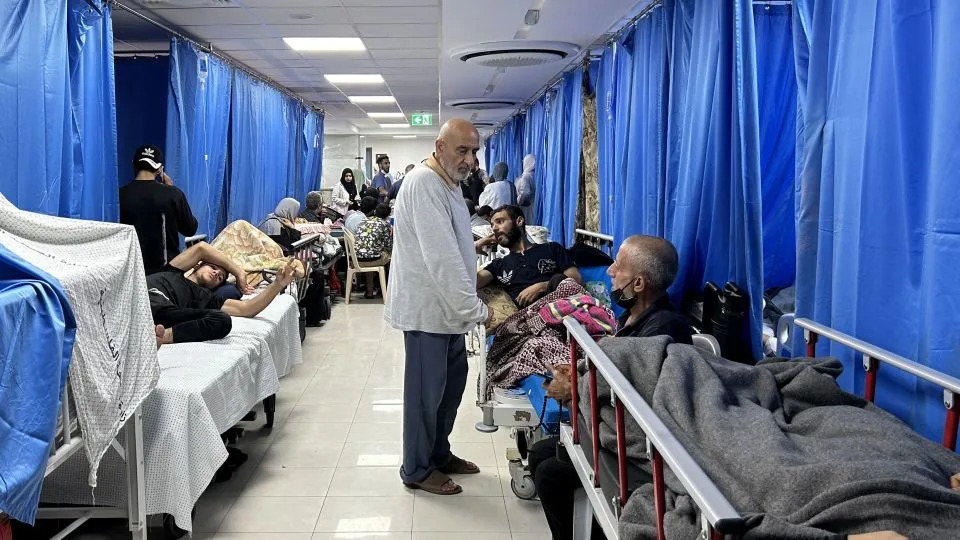
Patients and internally displaced people are pictured at Al-Shifa Hospital in Gaza City on November 10. - Khader Al Zanoun/AFP/Getty Images
FAJR Scientific and PAMA are among several US medical groups coordinating efforts. But so far, few have been able to reach hospitals under siege.
Since the start of the war, only about 900 trucks carrying international aid – but not fuel – have been allowed to enter Gaza through the Rafah border crossing with Egypt, according to the Palestine Red Crescent Society. That’s only a trickle compared to the approximately 500 trucks that entered each day before the war. PRCS warns that Gaza will need substantially more aid to meet growing humanitarian needs.
‘Waiting for a miracle’
Ahmad Muhanna, director of Al Awda Hospital in Jabalya, says the real nightmare is treating maimed children, whose faces he sees even when he closes his eyes.
“I’m being torn apart inside witnessing our children being martyred and receiving the carnage of their body parts, when they have no fault in this conflict,” Muhanna told CNN on October 29 from his hospital in northern Gaza.
Doctors are performing surgeries, including amputations, on children without clean water, let alone anesthesia or antibiotics, he says. Many are being treated on the floor due to a lack of empty hospital beds.
Israeli airstrikes at or near medical facilities have further complicated the matter, Muhanna, 49, adds. Medical workers are in constant danger.
As of November 10, 198 health care workers have been killed and 130 others wounded in Gaza, according to the Palestinian Ministry of Health in Ramallah. It also reports 21 hospitals and 51 primary health care centers are out of service.
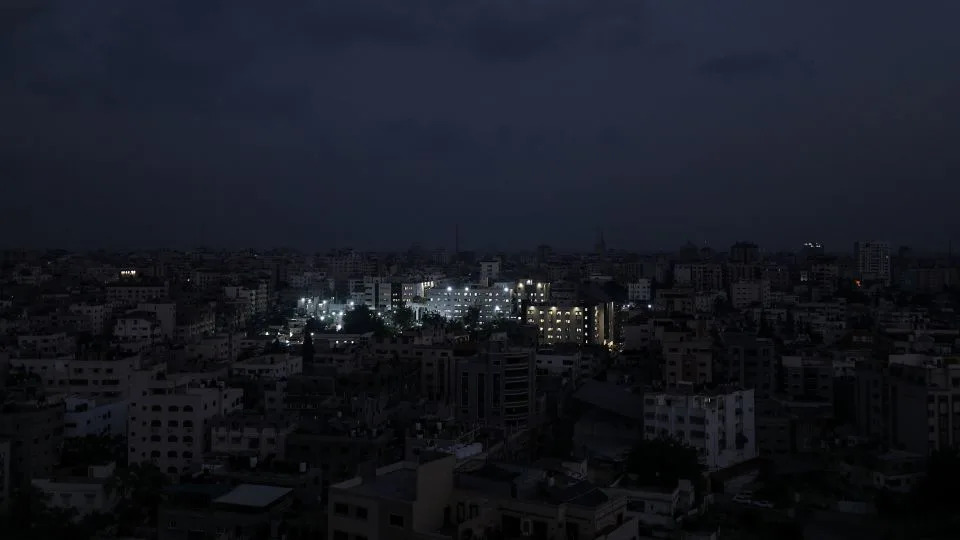
Al-Shifa Hospital is lit up in Gaza City amid fuel shortages on October 24. - Mohammed Saber/EPA-EFE/Shutterstock
Israel says it’s only targeting Hamas, whom it accuses of using hospitals to hide and launch attacks. The Palestinian Ministry of Health and Hamas deny such claims.
Israel says civilian deaths and the destruction of vital facilities, including hospitals, are collateral damage it tries to mitigate, and that Palestinians should flee to safer areas. But doctors in Gaza say it’s impossible to evacuate patients without causing more death, and that nowhere is truly safe.
“The Israeli air force is terrorizing us day and night above our tiny spot in the world,” said Muhanna, who believes high casualties prove Israel is not trying to mitigate civilian deaths. “They don’t have boundaries, no red lines they cannot cross. They have crossed every line by targeting women, elders, children, men, the disabled and every possible living thing.”
The chaos unfolding at Shifa, Al Awda and other hospitals across Gaza has left doctors exasperated. But with no ceasefire on the horizon and the borders tightly controlled, preventing vital supplies from reaching hospitals, more people will continue to die.
“We feel helpless towards our patients,” said Ghneim, the emergency room doctor at Shifa. “We want to provide patients with appropriate health care, but in many cases there’s nothing we can do.”
Meanwhile, Nasser and Musleh scramble to fundraise, buy supplies and coordinate shipping to the Rafah border crossing, where truckers anxiously await permission to enter Gaza and unload their life-saving cargo.
“The whole world turned their back on the people of Gaza,” Nasser said. “And right now we’re only waiting for a miracle.”
So like thousands of others, Mehna finally fled north Gaza for the south.
Perched on trucks, crammed into cars, pulled by donkeys on carts, and on foot, tens of thousands of Palestinians are fleeing Israeli army strikes on the territory squeezed between Israel, Egypt and the Mediterranean.
At the Bani Suheila crossroads in Khan Yunis, on the immense Salah Al-Din road that threads Gaza top to bottom, the processions are growing still.
People fleeing Gaza City are joined by those leaving Khan Yunis heading further south, towards Rafah, the last city before Egypt.
Mehna left the Jabalia refugee camp at seven in the morning, in the north of Gaza City, also hoping to reach Rafah.
But his journey finished in Khan Yunis, after eight hours of travel covering only 25 kilometres (15 miles).
"I already paid 500 shekels ($130) to come from Jabalia and so I have nothing more to carry on to Rafah," he said with a drawn face, surrounded by his six children.
'Not even a morsel of bread'
Because his sick wife is in a wheelchair, he had to rent "carts pulled by donkeys, trucks, cars" to transport her.
Each trip was short, as fuel shortages prevent drivers from accepting long-distance fares.
 A displaced Palestinian family from northern Gaza now shelters in the grounds of a Khan Yunis school © MAHMUD HAMS / AFP
A displaced Palestinian family from northern Gaza now shelters in the grounds of a Khan Yunis school © MAHMUD HAMS / AFPSometimes, between car rides, they were forced to go on foot. "So it was me who pushed my wife's chair," he told AFP.
Around him, hundreds of families were waiting.
Children sleep on the floor beside parents wondering how they will live in a territory where more than 1.5 million people are displaced and nearly one house in two has been destroyed, according to the United Nations.
In southern Gaza, overflowing with displaced from the north, rents of $150 a month are now up to $500 to $1000.
"I don't even have a morsel of bread to feed my kids," said Umm Yaaqub. "Since six in the morning I have been looking everywhere."
"I can't give them anything to eat," added the 42-year-old, who arrived in Khan Yunis three days ago with her husband and seven children from Gaza City.
The UN has said access to bread in the south is "challenging" because "the only operative mill in Gaza remains unable to grind wheat due to a lack of electricity and fuel".
On October 7 Hamas, in power in Gaza, launched an attack on southern Israel, killing some 1,200 people, mostly civilians and taking 239 hostages, according to Israel.
Since then Israel has been bombing the Gaza Strip and has killed more than 11,000 people, also mostly civilians, according to the Hamas health ministry.
 A displaced woman sits outside a makeshift tent in the grounds of a school in Khan Yunis © MAHMUD HAMS / AFP
A displaced woman sits outside a makeshift tent in the grounds of a school in Khan Yunis © MAHMUD HAMS / AFPBefore the war, a little over 80 per cent of Gazans lived in poverty and almost two-thirds were dependent on international aid, especially for food, according to the UN.
Now, 50-kilo sacks of flour have increased in price from 40 shekels to 150 shekels, so it's worse still.
'Not a single shekel'
But hunger is not the only worry for Umm Yaaqub. "My husband has heart problems," she says.
And her 20-year-old daughter Rim "is normally in a medical bed". "But we all sleep on the ground, in the dust, and we don't have a single blanket even though the nights are very cold."
Her husband Atef Abu Jarad, 47, remains in a classroom on the first floor of a school where the family camps now, next to dozens of other displaced.
"I'm the head of the family, but I don't have a single shekel to buy something for my kids to eat," he laments.
 Still time for play: displaced Palestinian children who now live in a Khan Yunis school © Mahmud HAMS / AFP
Still time for play: displaced Palestinian children who now live in a Khan Yunis school © Mahmud HAMS / AFPShops across southern Gaza are running out of everything. Bottled water, milk for children, nappies, pasta and juices are now nearly impossible to find.
A little food aid is trickling through to the displaced according to Abu Jarad: "a portion of rice to share between seven" members of his family.
"So I take a small spoon of rice and I tell them I'm full so they can eat," he says.
Water flows from a tap where long crowds of displaced people queue. "People push and I don't have the strength to resist," he says.
His daughter Rim had to give up the painkillers she has taken since birth, because she suffers spinal and shoulder malformations.
She too forgoes meals because her brothers and sisters "have more need to eat".
© 2023 AFP
‘Please stop this.’ Gaza’s hospitals are failing under the weight of war. US medical groups are scrambling to help
Alaa Elassar, CNN
Sat, November 11, 2023
Dr. Mohammed Ghneim has not left his hospital in Gaza City in four weeks. He can’t remember the last time he slept or ate, and his blue scrubs are stained in the blood of patients who’ve died in his arms.
His voice cracks under the weight of the horrors he’s seen: fetuses pulled from the wombs of dying mothers, children with crushed lungs struggling to breathe, and his own colleagues – doctors, nurses and EMTs – transported to the hospital morgue in body bags.
“We are doing our best – this is why we haven’t left here for days – but the situation is very horrible. There’s no way to describe it in any language or with any words,” Ghneim told CNN in a voice message on November 7, as sounds of chaos and panic unfolded around him. “Many times I want to go to the side and cry, but unfortunately there is no time.”
Ghneim is an emergency room doctor at Dar Al-Shifa, also known as Al-Shifa Hospital or Shifa, and is Arabic for “house of healing.” But at this hospital – the largest medical complex in Gaza – there’s far too much death.

A Palestinian child receives treatment at Nasser Medical Center after a strike in Khan Younis, Gaza, on November 7. - Ahmad Hasaballah/Getty Images
Shifa is running dangerously low on clean water, medicine, supplies and fuel. Meanwhile, thousands of Palestinians, injured or displaced by Israel’s war against Hamas, continue to pack its wards, seeking shelter from the seemingly endless barrage of airstrikes.
Israeli forces on Saturday surrounded Shifa in all directions, threatening the health and safety of those inside, according to Dr. Munir Al-Bursh, director-general of the Hamas-controlled health ministry in Gaza.
An Israeli airstrike destroyed the hospital’s generator, Al-Bursh said, cutting electricity to the building, including life-saving equipment used by 39 infants in neonatal care. Three infants have already died, he added.
The Israeli military denied that the hospital is under siege, telling CNN it was engaged in “ongoing intense fighting” against Hamas in the vicinity of Shifa, but declined to comment further on its forces’ proximity to the complex because military activity was still underway. Israel has accused Hamas of using hospitals as cover — a charge doctors at Shifa and the militant group deny.
“We are trained to deal with mass casualties, but not like this,” Ghneim, 28, said. “We have no anesthesia to treat patients with severe pain, patients with shrapnel in their head or abdomen, people whose arms or legs have been amputated.”

Palestinians inspect the damage to an ambulance struck by the Israeli military at the entrance of Al-Shifa Hospital in Gaza City. - Anas al-Shareef/Reuters
Alarming scenes from inside Shifa, and other hospitals across Gaza, have sparked international calls for a ceasefire and more aid to be allowed to enter the territory, home to some 2 million Palestinians, currently closed off to the world by Israel and Egypt.
Nonprofit medical groups across the United States are mobilizing to raise funds and ship medicine and supplies to failing hospitals before it’s too late. But with the situation in Gaza spiraling and few diplomatic or humanitarian solutions in sight, many worry the delay will result in more deaths.
“I want to say to the world, this is a humanitarian crisis, this is a genocide,” Ghneim pleaded from his crowded emergency room. “Please stop this.”
‘Desperate to send help’
More than 7,000 miles away, in Houston, Mosab Nasser is making travel plans to visit communities where he can spread awareness about the situation in Gaza and raise funds for struggling hospitals.
The proud Texan, born and raised in Gaza, says it’s all he’s been doing since October 7, when Israel declared war following a brazen attack by Hamas that killed around 1,200 people and took more than 230 others hostage, according to Israeli authorities.
Israel responded by imposing a siege and launching devastating airstrikes across Gaza, which Hamas governs. Israel says its goal is to destroy the militant group and return the hostages, but it is the Palestinian people living there who are bearing the brunt of the attacks.
The airstrikes have killed at least 11,025 Palestinians, including 4,506 children, and wounded more than 27,000 others so far, according to the Palestinian Ministry of Health in Ramallah, which draws its figures from sources in Hamas-run Gaza.
Nasser says three of his relatives – all young children, including one who was only 8 months old – were killed when Israeli airstrikes caused their home to collapse, but he has no time to grieve.
As CEO of the nonprofit medical group FAJR Scientific, he is obligated to find a way to deliver aid and other resources to hospitals in need.
FAJR Scientific’s goal is to raise enough money to fill five 40-foot containers with medical supplies, surgical tools and sterile instruments, and ship them to Gaza, Nasser says.
“Doctors in Gaza don’t get to go home. It’s traumatic for them,” Nasser said. “They are exhausted. Their bodies are physically at the hospital, but their minds are with their families trying to check on them.”

A Palestinian nurse at Nasser Hospital in Khan Younis, Gaza, mourns after receiving news that his brother was killed on November 9. - Abed Zagout/Anadolu/Getty Images
In some cases, Nasser says, medical workers have discovered their own loved ones among the injured or dead, compounding the fears and anxieties they already experience.
It’s not the first time FAJR Scientific has supported Gaza’s medical community. The group has led several surgical missions to Gaza and trained nearly 100 Palestinian medical workers on the ground, Nasser says. In August, they provided more than $4 million in medical supplies to hospitals across the territory.
The Palestinian American Medical Association (PAMA), another US-based nonprofit, is also leading efforts to assist health care workers in Gaza.
The group, which has more than 6,000 members and supporters and leads medical missions to the region, has raised over $2 million so far, PAMA president Dr. Mustafa Musleh told CNN.
They will use the money to purchase critical medicine and supplies, including anesthetics, antibiotics and other medications to fill containers that will be sent to Gaza. The group also has more than 1,000 health-care professionals on standby to enter the enclave as soon as Israel and Egypt allow entry to humanitarian workers, Musleh says.
“We’re desperate to send help,” the Palestinian American doctor from Dayton, Ohio, said. “It’s a catastrophic situation. … There’s 10 times more patients than what the hospitals can take care of and they’re all coming with serious life-threatening injuries that need immediate attention, and a lot of people die because of that.”

Patients and internally displaced people are pictured at Al-Shifa Hospital in Gaza City on November 10. - Khader Al Zanoun/AFP/Getty Images
FAJR Scientific and PAMA are among several US medical groups coordinating efforts. But so far, few have been able to reach hospitals under siege.
Since the start of the war, only about 900 trucks carrying international aid – but not fuel – have been allowed to enter Gaza through the Rafah border crossing with Egypt, according to the Palestine Red Crescent Society. That’s only a trickle compared to the approximately 500 trucks that entered each day before the war. PRCS warns that Gaza will need substantially more aid to meet growing humanitarian needs.
‘Waiting for a miracle’
Ahmad Muhanna, director of Al Awda Hospital in Jabalya, says the real nightmare is treating maimed children, whose faces he sees even when he closes his eyes.
“I’m being torn apart inside witnessing our children being martyred and receiving the carnage of their body parts, when they have no fault in this conflict,” Muhanna told CNN on October 29 from his hospital in northern Gaza.
Doctors are performing surgeries, including amputations, on children without clean water, let alone anesthesia or antibiotics, he says. Many are being treated on the floor due to a lack of empty hospital beds.
Israeli airstrikes at or near medical facilities have further complicated the matter, Muhanna, 49, adds. Medical workers are in constant danger.
As of November 10, 198 health care workers have been killed and 130 others wounded in Gaza, according to the Palestinian Ministry of Health in Ramallah. It also reports 21 hospitals and 51 primary health care centers are out of service.

Al-Shifa Hospital is lit up in Gaza City amid fuel shortages on October 24. - Mohammed Saber/EPA-EFE/Shutterstock
Israel says it’s only targeting Hamas, whom it accuses of using hospitals to hide and launch attacks. The Palestinian Ministry of Health and Hamas deny such claims.
Israel says civilian deaths and the destruction of vital facilities, including hospitals, are collateral damage it tries to mitigate, and that Palestinians should flee to safer areas. But doctors in Gaza say it’s impossible to evacuate patients without causing more death, and that nowhere is truly safe.
“The Israeli air force is terrorizing us day and night above our tiny spot in the world,” said Muhanna, who believes high casualties prove Israel is not trying to mitigate civilian deaths. “They don’t have boundaries, no red lines they cannot cross. They have crossed every line by targeting women, elders, children, men, the disabled and every possible living thing.”
The chaos unfolding at Shifa, Al Awda and other hospitals across Gaza has left doctors exasperated. But with no ceasefire on the horizon and the borders tightly controlled, preventing vital supplies from reaching hospitals, more people will continue to die.
“We feel helpless towards our patients,” said Ghneim, the emergency room doctor at Shifa. “We want to provide patients with appropriate health care, but in many cases there’s nothing we can do.”
Meanwhile, Nasser and Musleh scramble to fundraise, buy supplies and coordinate shipping to the Rafah border crossing, where truckers anxiously await permission to enter Gaza and unload their life-saving cargo.
“The whole world turned their back on the people of Gaza,” Nasser said. “And right now we’re only waiting for a miracle.”
No comments:
Post a Comment